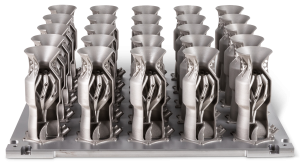
Making the most of additive manufacturing (AM) is not only about installing the technology. As with anything, the deeper the knowledge of the process, the more one can get out of it and the more applications can be developed. AM experts and application engineers are thus in a unique position, from which they can innovate and solve many challenges associated with traditional manufacturing.
Perhaps no area illustrates this dynamic better than fluid flow applications, which exist across many industries that are driving adoption of AM: from automotive and motorsports, to aerospace, energy and beyond. For years, our knowledge of fluid dynamics has gone beyond what we’ve been able to achieve using conventional manufacturing processes. Now, additive manufacturing is changing this reality, enabling engineers to produce optimised designs that would have previously been impossible to make.
Thanks to AM, it is now possible to create fluid flow systems that are superior in terms of performance, efficiency and reliability. In a new, free to download eBook, 3D Systems explores applications of its AM technologies for fluid flow systems, highlighting real and extensive benefits in terms of everything from performance to weight reduction.

Untethering design
Many of the benefits of additive manufacturing for fluid flow applications are related to design. Compared to subtractive manufacturing, AM offers an exceptional level of design freedom, allowing for the creation of parts with complex internal geometries and features. In short, this means that we can now conceive of new and better designs for fluid flow applications.
CERN, the Switzerland-based European organisation that operates the Large Hadron Collider (LHC), the world’s largest particle collider (and the world’s largest machine), partnered with 3D Systems’ Application Innovation Group (AIG) to redesign and manufacture titanium cool-bars for LHC experiments. AM enabled the partners to overcome several challenges associated with the parts, which are used to cool the detection area to -40 deg C to preserve particle reactions for study.

Chief among the challenges was space: the cool-bars had to fit into a limited space while still dissipating enough heat. They had to achieve temperature uniformity over the length of a photo-detection strip, which measures 140 meters in length and less than 2 mm in width. All while meeting flatness specifications for detector efficiency and resolution.
Based on these requirements, the partners conceived of the perfect part design. “This design was so beautiful, but it was not producible in the usual ways,” explained Antonio Pellegrino, a leader on the LHCb SciFi Tracker project at CERN.
Using Direct Metal Printing (DMP), 3D Systems’ AIG and CERN were able to manufacture more than 300 units of the titanium cool-bars, each of which met the necessary specifications, including 0.25 mm wall thicknesses (to improve heat dissipation), leak tightness and flatness with a precision of 50 microns. The full case study can be found here.
Flowing across industry segments

The benefits of AM in fluid flow systems extend well beyond CERN, from heat exchangers, to integrated cooling, to propulsion systems and fuel injectors, to fluid manifolds and all the way to microfluidics. AM is enabling improved efficiency for all these fluid flow applications, in more ways than one.
On the one hand, additive manufacturing can enable the production of more lightweight structures thanks to optimised geometries. This ability is especially crucial in applications like propulsion systems and fuel injectors, where weight is a critical factor and can drive up operating costs.
In designing a liquid rocket engine injector, for example, the German Space Center (DLR), in cooperation with the 3D Systems Customer Innovation Center, was able to consolidate 30 components into a single part, which resulted in a final weight reduction of 10 percent. On top of that, the consolidated design eliminated points of failure that existed in the original system, improving overall system performance. The 3D printed fuel injector also integrated certain features, like pressure and temperature sensor channels, which resulted in superior cooling and combustion performance. These performance-enhancing features were enabled by 3D Systems’ DMP technology.
“Based on the success of space-related initiatives involving DMP, we thought that 3D Systems was perfectly suited for providing the design-for-manufacturing aspects of the injector head, with an eye on new possibilities for sensor integration and fuel and coolant distribution,” explained Markus Kuhn, who is managing the injector head project at DLR.
A simply better flow
AM can also improve the efficiency of fluid flow applications by directly improving on fluid dynamics. Most conventional manufacturing processes favor designs with sharp corners, which can be problematic, as fluid moving through internal channels can become trapped in stagnant zones. This, in turn, leads to pressure loss and reduces efficiency. Design for AM can eliminate these troublesome design features and create internal channels that are optimised for fluid dynamics. These benefits can be seen most clearly in fluid manifolds in semiconductor machinery and microfluidic devices used in research labs.
Similarly, it is possible to design fluid flow systems with intentional turbulence to achieve peak cooling. In heat exchangers, for instance, built-in turbulence can increase thermal transfer, which can be useful in refrigeration appliances, energy generation and many other applications. Overall, AM enables engineers and fluid flow specialists to base designs off of fluid dynamics rather than on manufacturing limitations.

To sum it up, additive manufacturing is changing the state of fluid flow applications for the better, offering improved manufacturability through part consolidation, superior efficiency through weight reduction and mixing efficiency, and better space utilisation. This is true in virtually all fluid dynamics areas, whether you are 3D printing metal cool-bars for the LHC, a fuel injector, or a plastic microfluidic device with tiny channels.
Still, the learning curve can be fairly steep, as it encompasses not only a new manufacturing process but also a whole new design mindset. Fortunately, the experts are on hand to ease the adoption of AM. Partners like 3D Systems can help end users to make the most out of 3D printing for fluid flow applications, through consulting, as well as through training and manufacturing services. The company says: “We help to discover where and how AM fits within an existing architecture, and advise on how to simplify the onboarding process.”
Еще больше новостей |




